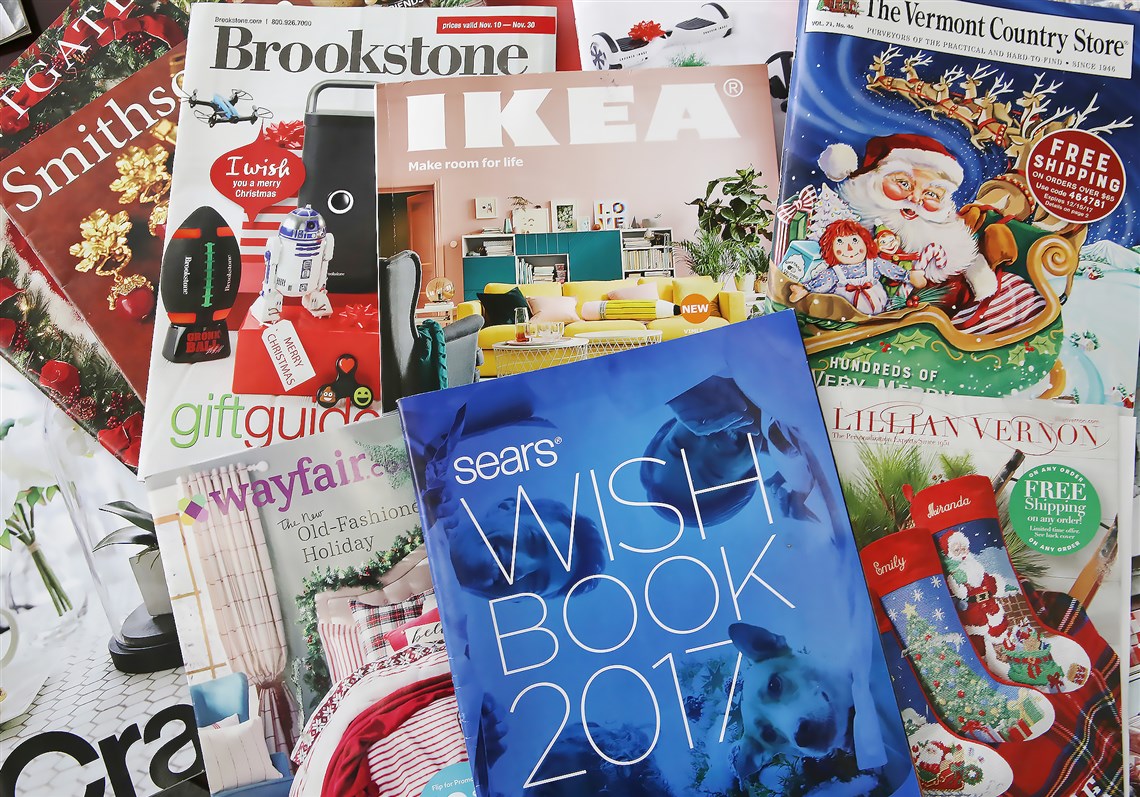
In one TV commercial from this year’s Toys R Us holiday campaign, a mom sweats through her cycling workout while her suspiciously helpful daughter tries to stir up a breeze.
“I’m just gonna leave this right here,” the girl says, covering the stationary bike’s display with her impromptu fan — an old-school mail-order catalog.
The Toys R Us catalog appears in several of the toy merchant’s holiday ads, which coach kids that “the naughty list is not an option.”
In a time of explosive growth for online buying, retailers and shoppers are showing renewed interest in a humble purchasing device that uses paper instead of pixels.
To read the entire article, copy and paste the following link into your browser: http://www.post-gazette.com/business/money/2017/11/24/Retailers-take-another-look-at-printed-catalogs-online-shopping-email-fatigue/stories/201711250034
For the first time since 2011, Sears Holdings sent out the Sears Wish Book, a holiday tradition for generations of children. Although this year’s catalog has the heft of a magazine rather than the phone-book size the department store chain produced when it was a retail juggernaut, the offerings are more extensive and searchable online.
Neiman Marcus Group, in the 2017 edition of its venerable Christmas Book, used a social media contest for 1,500 photos capturing happy moments to be featured in a cover collage. And home furnishings retailer Wayfair.com started mailing full-line catalogs last year.
Lauren von Bernuth, a Los Angeles boxing trainer, said the Sears and Neiman Marcus catalogs bring back pleasant memories of looking through them.
“It’s nice to just put the phone down for once and have a physical object in your hands,” Ms. Von Bernuth said. Amazon.com “just doesn’t have that Christmas vibe.”
Fewer catalogs are in the mail these days, 9.8 billion in 2016 compared with the 2007 peak of 19.6 billion, but consumers are paying more attention to them than ever, according to research by the Data & Marketing Association and the U.S. Postal Service.
“The ability to stand out in that physical mailbox is easier than it was 10 years ago,” said Neil O’Keefe, senior vice president of content and marketing for the DMA. “Marketers are taking advantage of that and they are beginning to see a positive response.”
In 2016, the response to catalogs increased 23 percent from the year before, Mr. O’Keefe said.
Companies are using print catalogs to cut through email clutter and social media saturation, said Denise Lee Yohn, a retail brands expert. The catalogs help “differentiate brands and sustain existing customer relationships,” she said.
That works for Natalie Montoya Farrow, who likes to relax with a glass of wine and the Anthropologie catalog of clothing and decor.
“It’s colorful and inspiring, not just shot in a studio, but on location,” Ms. Farrow said. “They use very thick paper, so it’s tactile. Something real in a world that seems to be becoming less so.”
Social media has made her “hyperaware of everything, so it’s nice to sit and fantasize with a catalog,” she said.
Ms. Yohn said catalogs won’t help all struggling brands.
“Resurrecting the Sears catalog might have been a good idea five years ago when the brand still enjoyed enough goodwill and the company still had some great product brands,” Ms. Yohn said. “But at this point, nothing is going to save that company.”
Mr. O’Keefe said print catalogs will never be as popular as they once were, but retailers appear to be using them as part of what he called an “omnichannel” approach that tries to more closely integrate a store’s website with its physical stores, such as buying online and picking up at the store the same day.
A survey included in a recent DMA report found that nearly one-third of those polled said getting a catalog drove them to shop online.
Sears was looking for some of that success when it brought back its Wish Book.
The catalog “had to draw in the digital experience of shopping online and be interactive,” Sears spokesman Brian Hanover said. “So, there’s the capability to create Wish Lists. You can hover over items and mark them with a heart, and then share those with your family, your friends.”
Neiman Marcus executives felt the catalog deserved something extra in the company’s 110th year, said Theresa Palermo, vice president of brand marketing and public relations for the Neiman Marcus Group.
But the response was much bigger than expected when the retailer ran a contest for a chance to get a tiny photo on the Christmas Book’s cover. For 1,500 spots, the company received submissions from 17,000 people.
“We wanted the holiday book to create a story, a memory for consumers,” Ms. Palermo said, “not just through the user-generated content like the photos, but also in the writing of it, the colorful displays, the way it features our products.”
